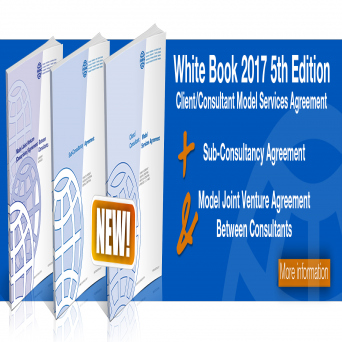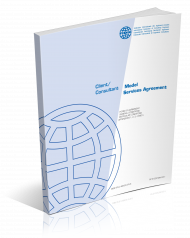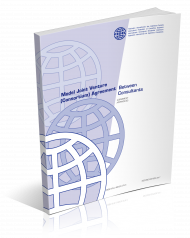Review of the new FIDIC Suite of Agreements ( ed.2017)

The consulting engineering industry has become increasingly global in its nature and in the way it does business. Best practices and international standards play an increasing role in that business, whether firms operate nationally, or internationally. FIDIC, as the global voice of the Consulting Engineering industry, is also focused on meeting this challenge. It prepares best practice tools and guidance for all its members and all consulting firms, irrespective of whether they operate nationally or internationally. With the increased demand for sustainable infrastructure, the industry faces a world-wide shortage of skilled advisors – there is also a growing need for greater innovation in managing resources – in the Consulting Engineering industry, the most important resource is people. Coupled with the demand for services, is the need for greater clarity on the role of the Consulting Engineer, and the value of the services provided. The quality of life is the driving force behind this dynamic industry. FIDIC is therefore proud to launch not one, but three new agreements, designed to offer guidance and practical assistance to the industry on sound methods for collaboration in the provision of services to clients and communities anywhere in the world.
THE NEW CLIENT/CONSULTANT MODEL SERVICES AGREEMENT (the White Book) is suitable for general use for most services provided by consulting engineers, including pre-investment and feasibility studies, detailed design, construction administration and project management, both for Employer-led design teams, and for Contractor-led design teams on design and build commissions.
The Agreement is suitable for international projects but can equally be used on domestic projects. In fact, during the development of this Model Agreement, FIDIC looked at over 20 different forms of agreement used by member associations. It is recognised that, whilst there are numerous clauses which will be generally applicable in most situations, there are some provisions which must necessarily vary to take account of the circumstances and locality in which the Services are to be performed. The General Conditions are linked with the Particular Conditions by the corresponding numbering of the clauses so that the General Conditions and Particular Conditions together comprise the conditions governing the rights and obligations of the parties. Those familiar with the FIDIC forms of construction contract will recognise the similarity in approach.
The Particular Conditions must be specially drafted to suit each individual Agreement and type of Service. References to the General Conditions are in Part A whilst any amendments to the General Conditions or additional clauses are in Part B. These pages must be completed for incorporation into the Agreement.
HOW THIS IS DONE ? FIDIC intends to publish an updated “White Book Guide” which will include commentary on the clauses in the White Book and guidance on completion of the Appendices. Users of the White Book in the meantime can refer to various other FIDIC publications available in the FIDIC Bookshop. Those involved in preparing a Scope of Work in Appendix 1 may wish to consult the two FIDIC Definition of Services guides.
WHAT’S NEW IN THE WHITE BOOK? This Fifth Edition of the White Book has enhanced the “duty of care” obligations placed on the Consultant in providing specified services to a client. In doing so, FIDIC considered the following issues, all of significance to consulting engineers anywhere:
- up to date practice worldwide in drafting consultancy agreements
- a fair balance of risk between the Client and the Consultant
- the professional’s obligation with respect to due skill and care, and fitness for purpose
- the availability of suitable insurance
FIDIC has recognised considerable pressure from some parts of the industry to enhance the obligations placed on the Consultant to ensure that the professional services and deliverables are fit for purpose. The problem confronting FIDIC is that there is no common understanding of due skill and care or fitness for purpose, either between clients and consultants, or between legal advisors in various jurisdictions, despite the wide usage of such terms globally.
In looking at this problem FIDIC accepted that the Client is entitled to expect that the professional services will be completed correctly and that all the specific contractual requirements will be met. If these are not correct, or any requirement has not been fulfilled, then the Client should be entitled to appropriate redress against the Consultant. This approach assumes that the Consultant is fully experienced and competent in the delivery of the relevant services, and accordingly, an appropriate stipulation has been added to the new White Book.
It is all about understanding the nature of the services of the consulting engineers, and assessing a fair balance of risk between the Client and the Consultant.
It is well known in the industry that Consultant’s cover their liability under contract by taking out professional indemnity insurance. FIDIC is satisfied that professional indemnity insurance policies do not cover liability for defective or inadequate services without evidence of fault or breach on the part of the Consultant. Such insurance only covers liability where there is a failure on the part of the Consultant to use the reasonable skill and care to be expected from an experienced consultant (this in turn links to another long standing debate within the industry, on selecting the appropriate consultant based on quality and experience (rather than on price).
The Task Group also examined whether the normal obligation placed on Consultants to use reasonable skill and care in delivering their services was an industry standard. The 20 standard forms of appointment used in other countries were closely examined. It was noted that none of these forms of appointment required professional services to be fit for purpose. Nor did they impose strict liability for defects. The standard, whether expressed or implied, is reasonable skill and care. Accordingly, the Task Group determined that it was not a fair or reasonable balance of risk to make the Consultant strictly liable for the outcome of professional services in situations where there was no evidence of fault or breach by the consultant.
Further information on the practices in different countries, and the challenges faced, because of ignorance on, or lack of understanding about the key issues, are available in the Foreword and in other FIDIC guides.
Users of this Fifth Edition Agreement will therefore be confident that common used and accepted standards are used, emphasizing the Consultant’s obligation to use the reasonable skill and care to be expected from a consultant experienced in the provision of services for projects of similar size and complexity. In addition, it is recognised that the services must be performed with a view to satisfying any function and purpose described in the Agreement, but without extending this commonly accepted obligation. As such, this obligation should be fully insured under any professional indemnity insurance policy, in order to benefit both the Client and the Consultant – this represents the correct balance of risk between the two parties.
THE NEW FIDIC JOINT VENTURE AGREEMENT : FIDIC has developed model forms for two types of associations between service suppliers - this Model Joint Venture Agreement and a Model Sub-Consultancy Agreement.
These two model forms of agreement are compatible with the 2016 fifth edition of FIDIC’s “Client/Consultant Model Services Agreement“(the White Book). FIDIC intends to publish Guides on the use of all of these Agreements.
This model Joint Venture Agreement will allow the parties to agree, on a project-specific basis, their obligations, services and rewards within the Joint Venture created among them by the effect of this Model Joint Venture Agreement. It is not intended to create a legal entity or to be used to create a more permanent non-project specific legal association.
The Joint Venture´s action, capacities and internal decision making processes have been clearly structured.
One purpose of a model agreement such as this is to raise the awareness of the Members of the Joint Venture as to what should be in the Agreement to mitigate their individual risks and avoid disputes between themselves.
A second purpose is to provide the Members with a manageable agreement which establishes clear responsibilities and legal capacities to act. It is aimed at avoiding disputes and deadlocks between the Members.
In countries where it is inappropriate to use the description “Joint Venture” for the type of project-specific association described above, the wording in the Joint Venture Agreement can be changed accordingly.
It must be remembered that it is the Joint Venture Members as the Joint Venture who will be contracting with the Client, and therefore, it is the Joint Venture Members together, as the Joint Venture, who will be the “Consultant” as defined in the “Client/Consultant Model Services Agreement“ (the White Book), or any other form of Services Agreement.
Users should check on a case-by-case basis the precise nature of this Agreement in light of the governing law, assuming that the lowest level of alliance is intended. This Model Joint Venture Agreement does not create a legal entity, but is an agreement between parties to associate for a specific project. The individual Members need to agree the allocation among themselves of the obligations and liabilities within the Joint Venture. Towards the Client, each Member will typically be jointly and severally liable for the performance of Services under the main Services Agreement with the Client and for any breach of that agreement. At the same time the sharing of duties and liabilities requires the Joint Venture Members to coordinate their efforts in an effective and efficient manner.
Certain issues deserve detailed attention to ensure that, when the Joint Venture is appointed, each Member undertakes its agreed tasks and obligations.
In particular, the matter of insurances and guarantees requires early attention to ensure that the professional liability of the Joint Venture is fully covered.
Further guidance is available from FIDIC but, in all cases, it is recommended that legal advice be obtained.
When transfer of technology is an important part of a project, this should be set out in the written appointment and terms of the Services Agreement.
The transfer of technology should be specified in Appendix 3 [Allocation of the Obligations] in accordance with Clause 4 [Performance of the Services] as follows:
- The specific knowledge and skill to be transferred and how this will be done;
- The criteria to be used to determine to what degree the objective has been achieved;
- The budget to be set aside specifically for the transfer of technology which must include the provision of the required tools, such as hardware, software, technical literature, laboratory equipment, and survey equipment;
- The staff to be involved, their qualifications and experience and the amount of time to be used for training purposes. This applies to both sides of the transfer of technology - the recipient personnel as well as the teaching staff should have the availability of time required by the Services Agreement and/or this Agreement;
- The criteria to be used to measure «on the job» training; and
- The consequence of the transfer of technology programme on the project schedule.
The emphasis of the main Services Agreement, e.g. the Client/Consultant Model Services Agreement (“White Book”) is on the fulfilment of obligations under that Services Agreement (“White Book”), rather than the assignment of different tasks to the Members.
THE SUB-CONSULTANCY AGREEMENT has been developed from the Fifth Edition 2016 of the Client/Consultant Model Services Agreement “White Book” and is intended to be used where a Consultant appointed under the White Book wishes to engage a Sub-Consultant to undertake part of the Services. The Sub-Consultancy Agreement therefore incorporates many of the terms and conditions of the White Book such that the obligations and rights of the Sub-Consultant are largely consistent with those of the Consultant under the White Book.
It is intended that the head contract («the Client / Consultant Agreement») is appended at Annex A such that the Sub-Consultant will have its own copy of the Client / Consultant Agreement and can see the obligations undertaken by the Consultant and for which the Sub-Consultant is now engaged. The Client /Consultant Agreement appended at Annex A need not include matters that do not concern the Sub-Consultancy Agreement and need not include commercial matters as between the Consultant and the Client. Annex A does not form part of the Sub-Consultancy Agreement but is a document referred to in it that must be complied with in the same way as a code of practice or a building regulation.
Whilst the Sub-Consultancy Agreement has been written specifically to facilitate the appointment of a Sub-Consultant where the Consultant is appointed under the primary FIDIC form of a Client/Consultant Model Agreement (the White Book) it may equally be used, with minimal amendments, where the head contract is not the White Book. As noted with the new FIDIC White Book, FIDIC has acknowledged that there are numerous similar forms of Agreement in many countries, but very few agreements for sub-consultants. This then is offered to the market as a stand-alone best practice.
>> Latest Agreements Collection available for purchase in print or electronic.
>> Complimentary webinar & Online Course.
ACKNOWLEDGEMENTS |
This article was written by Mike Roberts, Member of the FIDIC Contracts Committee and principal drafter of the new FIDIC Suite of Agreements. FIDIC extends special thanks for the preparation of this Fifth Edition 2017 of the Client/ Consultant Model Services Agreement to the members of its Task Group : Vincent Leloup, Managing Partner, Exequatur, France; Juan Carlos Moncada Bueno, TYPSA, Spain; Ulla Sassarsson, FRI, Denmark; Jeroen van Gessel, Witteveen & Bos, Netherlands.
|









